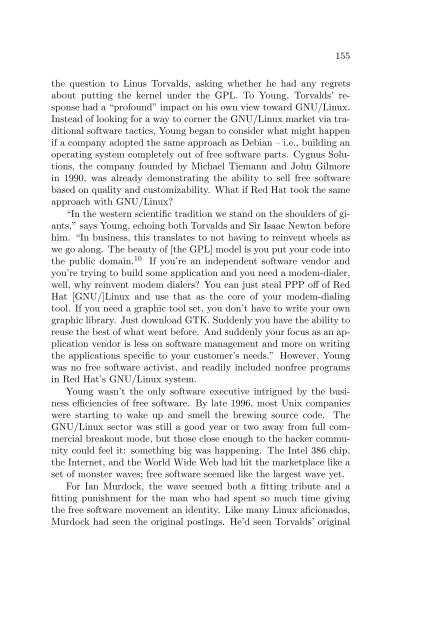You also want an ePaper? Increase the reach of your titles
YUMPU automatically turns print PDFs into web optimized ePapers that Google loves.
155<br />
the question to Linus Torvalds, asking whether he had any regrets<br />
about putting the kernel under the GPL. To Young, Torvalds’ response<br />
had a “profound” impact on his own view toward GNU/Linux.<br />
Instead of looking for a way to corner the GNU/Linux market via traditional<br />
software tactics, Young began to consider what might happen<br />
if a company adopted the same approach as Debian – i.e., building an<br />
operating system completely out of free software parts. Cygnus Solutions,<br />
the company founded by Michael Tiemann and John Gilmore<br />
in 1990, was already demonstrating the ability to sell free software<br />
based on quality and customizability. What if Red Hat took the same<br />
approach with GNU/Linux?<br />
“In the western scientific tradition we stand on the shoulders of giants,”<br />
says Young, echoing both Torvalds and Sir Isaac Newton before<br />
him. “In business, this translates to not having to reinvent wheels as<br />
we go along. The beauty of [the GPL] model is you put your code into<br />
the public domain. 10 If you’re an independent software vendor and<br />
you’re trying to build some application and you need a modem-dialer,<br />
well, why reinvent modem dialers? You can just steal PPP off of Red<br />
Hat [GNU/]Linux and use that as the core of your modem-dialing<br />
tool. If you need a graphic tool set, you don’t have to write your own<br />
graphic library. Just download GTK. Suddenly you have the ability to<br />
reuse the best of what went before. And suddenly your focus as an application<br />
vendor is less on software management and more on writing<br />
the applications specific to your customer’s needs.” However, Young<br />
was no free software activist, and readily included nonfree programs<br />
in Red Hat’s GNU/Linux system.<br />
Young wasn’t the only software executive intrigued by the business<br />
efficiencies of free software. By late 1996, most Unix companies<br />
were starting to wake up and smell the brewing source code. The<br />
GNU/Linux sector was still a good year or two away from full commercial<br />
breakout mode, but those close enough to the hacker community<br />
could feel it: something big was happening. The Intel 386 chip,<br />
the Internet, and the World Wide Web had hit the marketplace like a<br />
set of monster waves; free software seemed like the largest wave yet.<br />
For Ian Murdock, the wave seemed both a fitting tribute and a<br />
fitting punishment for the man who had spent so much time giving<br />
the free software movement an identity. Like many Linux aficionados,<br />
Murdock had seen the original postings. He’d seen Torvalds’ original


